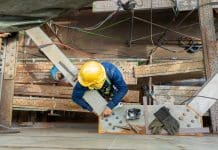Scaling up the Social Housing Decarbonisation Fund: a significant step in the right direction, but more action is needed, says Homelink CEO Chris Jones
The recent report from the IPCC serves as a final warning on the urgent need for action to prevent catastrophic changes to our planet’s vital systems. With the recognition that we all have a part to play in addressing climate change, it is clear that urgent action is needed across all sectors, from industry and business to government and individual citizens. One area that can make a significant impact in the UK is the improvement of home performance, potentially via the Social Housing Decarbonisation Fund (SHDF).
Currently, UK homes are amongst the leakiest and coldest in Europe, contributing around 20% of the country’s total greenhouse gas emissions. By upgrading and improving the energy efficiency of our homes, we can substantially reduce our carbon footprint and make a meaningful contribution towards reducing our carbon footprint.
Social Housing Decarbonisation Fund Wave 2.1
This is by no means a simple task. How, for example, do we incentivise homeowners to spend their dwindling incomes on home upgrades during a cost of living crisis, let alone enabling a coordinated approach which leads to the scale required. Other tenures offer hope, however.
The announcement of the next wave of the Social Housing Decarbonisation Fund investment will have substantial benefits in improving the energy performance of England’s social housing. A total of £778m was allocated to 107 projects, with match funding contributing a further £1.1bn.
It is estimated that this will lead to the upgrade of 90,000 homes and provide better quality, warmer homes that are cheaper to heat and healthier to live in to a significant proportion of people living in poor conditions. It’s a hugely important step in improving our homes and the lives of those living in them.
However, it’s worth noting that the homes targeted for improvement under this funding represent only 6.5% of all social homes that require upgrades to achieve an EPC rating of C. If we consider all homes with an EPC band D-G across England, these 90,000 just represent 0.7%.
The scale of the challenge we face is massive. Improving all homes up to at least this level will bring about a 30% reduction in carbon emissions. It is estimated that it will cost at least £55bn up to 2050 to improve the 5m social homes across the UK.
Accelerating these upgrades will likely reduce the overall cost of delivery. Combined with the high cost of energy bills, we must find delivery mechanisms that incorporate energy savings to reduce the overall cost and increase return on investment.
In this regard, the earlier we act, the lower the cost.
A further concern is that previous waves of SHDF have failed to deliver, with less than 10% of the 20,000 homes expected to be upgraded receiving measures during Wave 1 of the programme so far.
This is due to a skills gap in the sector as well as increased costs and shortages of materials. Without a focus on the development of green skills and robust supply chains to deliver upgrades, we risk wasting newly announced funding, leading to further delays.
EPCs – help or hindrance?
We must also ensure retrofits provide the performance and improvement benefits as well as energy cost savings they promise. The current model of energy performance assessment uses partly subjective tools and is blind to building performance once homes are occupied.
SAP and RdSAP (the assessment methodologies for defining EPCs) are based upon outdated data and, although often well-intentioned, regularly use assumptions to calculate the energy performance of buildings based upon their age and construction characteristics.
A recent update to SAP, SAP 10, goes some way to resolving these issues by, for example, reducing the carbon emission factor of electricity by more than half. A further issue of this method of building performance assessment is that it does not consider the building’s use and the behaviour of its occupant(s).
EPCs are widely used across the housing sector to classify energy performance of homes. There is a requirement to have a valid EPC in place when a home is sold or there is a change in occupancy. These ratings can be up to 10 years old, with no requirement to update them when improvements are made.
Additionally, they are often used as a method of measuring improvements, particularly as targets for public funding opportunities.
The SHDF, for example, targets EPC C across most properties receiving upgrade measures, whilst the Energy Company Obligation (ECO) specifies improvements to EPC C or D, depending on the starting performance.
Understanding indoor environments
We spend around 90% of our time in indoor environments, the majority of which will be at home. Technologies exist to measure the underlying conditions in indoor environments, which can have significant impacts on our health and wellbeing.
Improving the data we have on our homes can lead to a wealth of benefits, to both occupants and owners (if different). An improved EPC won’t always translate into energy and cost savings, especially if assumptions are incorrect.
Continuous measurement gives insight into how the home performs given the activity of its occupants, providing data to inform how this might be optimised.
This vital information provides insight into the actions that need to be taken, including improving insulation, upgrading heating systems, or simply adjusting the settings on existing heating systems.
Measuring internal conditions and energy consumption prior to, and after any upgrade works also provides a means of illustrating the impact of installed measures. This provides valuable information on whether the measures have achieved the intended outcomes, value of return on investment (particularly when considered alongside associated energy savings), and can inform future improvement programmes for landlords with larger portfolios.
There are clear links between the energy performance and indoor conditions such as indoor air quality and issues like damp and mould, which have direct impacts on human health.
Retrofitting properties and resolving undesirable indoor conditions are two sides of the same coin
For example, increasing the thermal efficiency of a home and ensuring sufficient levels of ventilation significantly reduces the risk of damp and mould developing.
Poor quality housing which exposes residents to issues such as excess cold, damp, and mould, cost the NHS £1.4bn per year, evidencing the wider societal benefit of improving our homes.
Connected homes can help deliver greater energy efficiency
Collecting the data from our homes is the first step in improving measured performance. But this data is of little use without good quality analysis from which insight and action can be inferred.
At Aico HomeLINK, we are developing a suite of analytical insights from which property owners can take action to improve their homes, using the data we collect from more than 200,000 connected devices in social homes.
Indoor environmental sensors measure temperature, humidity, and carbon dioxide across the home. Together with remote monitoring of our market-leading fire and carbon monoxide alarms, this data is presented to property owners via the HomeLINK Portal, providing key insight into how each property is performing in areas such as heat loss, indoor air quality, and the risk of damp and mould development.
The granularity of the data collected also provides capability to identify likely root causes of issues, for example through the identification of heating and ventilation patterns.
These sensors are typically deployed for an isolated purpose, which could be measuring thermal performance or identifying risks to resident health, and they provide a cost-effective method of doing so.
Their real value, however, comes from their combined utility, particularly when installed in unison with fire and carbon monoxide sensors and other existing infrastructure such as smart meters; providing a method of whole-house, ongoing condition monitoring, which provides deep insight, at a fraction of the cost of more expensive, point-in-time assessments, which are often heavily reliant on standardised calculations and wider assumptions.
In conclusion, the announcement of the second wave of the Social Housing Decarbonisation Fund (SHDF) is a positive step forward in addressing the issue of decarbonising UK homes. The funding will upgrade 90,000 homes to improve their energy efficiency, ultimately reducing the country’s carbon footprint.
However, it is important to note that this represents just 6.5% of social homes that require upgrades to achieve an EPC rating of C. The scale of the challenge is huge, but it is essential that we find a way to incentivise landlords to make the necessary improvements to their homes.
With the high cost of energy bills, incorporating energy savings into the delivery mechanism of retrofits could help to reduce the overall cost and increase return on investment.
Ultimately, a continuous measurement of performance and improvements is needed to ensure that we achieve the desired outcome of improved energy efficiency, reduced carbon footprint, and a healthier indoor environment.

















